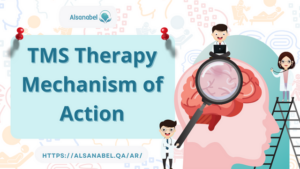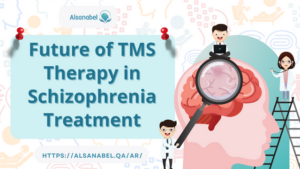TMS Therapy for Schizophrenia Patients 2024
- Category TMS effects
In the realm of schizophrenia treatment, Transcranial Magnetic Stimulation (TMS) has emerged as a promising therapeutic approach. Our extensive research findings reveal a significant body of evidence supporting the efficacy of TMS in alleviating both positive and negative symptoms of schizophrenia, particularly in reducing auditory hallucinations.
Table of Contents
ToggleTMS Therapy Mechanism of Action
Transcranial Magnetic Stimulation (TMS) therapy, primarily used for depression, is being researched for its potential in treating schizophrenia. Though its exact mechanism isn’t fully understood, several hypotheses exist:

- Modulation of Cortical Excitability: TMS targets specific brain regions like the dorsolateral prefrontal cortex (DLPFC) and temporoparietal junction (TPJ), potentially normalizing neural activity and reducing symptoms.
- Neuroplasticity Effects: TMS induces changes in synaptic plasticity and neurotransmitter levels, potentially promoting adaptive brain changes and symptom improvement.
- Modulation of Neurotransmitter Systems: TMS may influence dopamine, glutamate, and GABA systems, addressing dysregulation seen in schizophrenia.
- Normalization of Neural Oscillations: TMS may restore abnormal neural oscillations, enhancing rhythmic activity and synchrony between brain regions.
- Effects on Brain Connectivity: TMS could modulate connectivity between brain networks like the default mode network (DMN) and salience network, potentially alleviating psychosis and cognitive symptoms.
Further research, including clinical trials and neuroimaging studies, is ongoing to better understand TMS’s mechanisms and optimize its use in treating schizophrenia.
Benefits of TMS Therapy for Schizophrenia Patients
TMS treatment, known for treating depression, shows promise for schizophrenia treatment, offering several potential benefits:
- Reduction in Auditory Hallucinations: Targeted TMS may lessen auditory hallucinations by modulating brain activity in relevant regions.
- Improvement in Negative Symptoms: TMS shows potential in addressing negative symptoms like social withdrawal, possibly by enhancing neural plasticity.
- Enhancement of Cognitive Functioning: TMS applied to the prefrontal cortex improves cognitive deficits associated with schizophrenia.
- Adjunctive Treatment to Antipsychotic Medications: TMS sessions can complement antipsychotics, offering an alternative or additional treatment option for symptom management.
- Potential for Long-Term Symptom Relief: While ongoing research is exploring its duration, TMS may provide sustained relief beyond treatment periods.
- Minimal Side Effects: TMS is generally well-tolerated with transient side effects, making it appealing for patients sensitive to medication.
- Non-Invasive and Safe: Being non-invasive and outpatient, TMS poses minimal risk and allows immediate resumption of daily activities.
Further research is needed to determine efficacy, optimal parameters, and long-term outcomes, but these benefits underscore TMS’s potential as an adjunctive treatment for schizophrenia, improving patients’ quality of life.
Efficacy of TMS Therapy in Treating Schizophrenia
Transcranial Magnetic Stimulation (TMS) therapy’s efficacy in treating schizophrenia is actively researched, with evolving findings:
- Reduction in Auditory Hallucinations: TMS targeting specific brain regions shows promise in reducing auditory hallucinations, with immediate and sometimes lasting effects.
- Improvement in Negative Symptoms: Modest improvements in negative symptoms have been observed following TMS treatment, though responses vary.
- Enhancement of Cognitive Functioning: TMS applied to certain brain areas improves cognitive functions like attention and memory, potentially aiding functional recovery.
- Adjunctive Treatment to Antipsychotic Medications: Combining TMS with antipsychotics may lead to additional symptom relief and better outcomes compared to medication alone.
- Mixed Findings and Variable Response: Studies report mixed results, with some showing efficacy while others find no significant benefit, influenced by treatment protocols and patient characteristics.
- Need for Further Research: Large-scale clinical trials are needed to confirm TMS’s therapeutic benefits, establish optimal parameters, and understand long-term outcomes.
While promising, TMS’s role as a standalone treatment for schizophrenia requires further clarification through rigorous research.
TMS Therapy Procedure for Schizophrenia Patients
Transcranial Magnetic Stimulation (TMS) therapy is non-invasive and involves delivering magnetic pulses to specific brain areas. While primarily for depression, it’s being researched for schizophrenia treatment. Here’s an overview of TMS treatment for schizophrenia:
- Patient Assessment: Patients undergo psychiatric evaluation to assess symptoms and suitability for TMS.
- Treatment Planning: Based on evaluation and imaging, target brain regions like the temporoparietal cortex or DLPFC are identified.
- Treatment Sessions: Multiple sessions over weeks, lasting 20-30 minutes, are typical, adjusted based on response.
- Stimulation Parameters: Magnetic pulses, adjusted for frequency and intensity, aim to modulate brain activity.
- Monitoring and Assessment: Patients are monitored for response and adverse effects, using scales and imaging to evaluate outcomes.
- Maintenance and Follow-Up: Maintenance sessions may follow initial treatment to monitor long-term effects and prevent symptom recurrence.
- Integration with Other Treatments: TMS is part of a comprehensive treatment plan, often alongside medication and therapy.
Individual protocols may vary, emphasizing collaboration among specialists for safe and effective treatment.
Future of TMS Therapy in Schizophrenia Treatment
The future of Transcranial Magnetic Stimulation (TMS) therapy in schizophrenia treatment is promising, with ongoing research aiming to:

- Refine Targeted Stimulation Approaches: Using advanced neuroimaging to pinpoint optimal brain targets for precise symptom modulation.
- Personalize Treatment Strategies: Tailoring TMS parameters and schedules based on individual patient characteristics and treatment response profiles.
- Integrate Neuroimaging and Biomarkers: Incorporating neuroimaging techniques to understand TMS effects and identify predictive biomarkers for treatment response.
- Explore Combination Therapies: Investigating synergistic effects of combining TMS with pharmacotherapy or behavioral interventions.
- Assess Long-Term Effects: Longitudinal studies to evaluate the sustained efficacy and durability of TMS treatment, along with developing maintenance protocols.
- Innovate TMS Technology: Advancements in coil designs and stimulation paradigms to enhance precision, efficiency, and safety of TMS.
- Establish Clinical Guidelines: Developing standardized protocols and guidelines for safe and effective TMS therapy in schizophrenia.
Collaboration between researchers, clinicians, and industry stakeholders will be crucial to realizing TMS’s full potential as a therapeutic tool in managing schizophrenia.
Thank you for taking the time to learn about the promising approach of TMS therapy for schizophrenia patients. If you or a loved one is struggling with this condition, consider discussing the potential benefits of TMS therapy with a healthcare provider. As always, we value your feedback and would love to hear your thoughts on this innovative treatment option. Let’s continue to spread awareness and support for those affected by schizophrenia.









